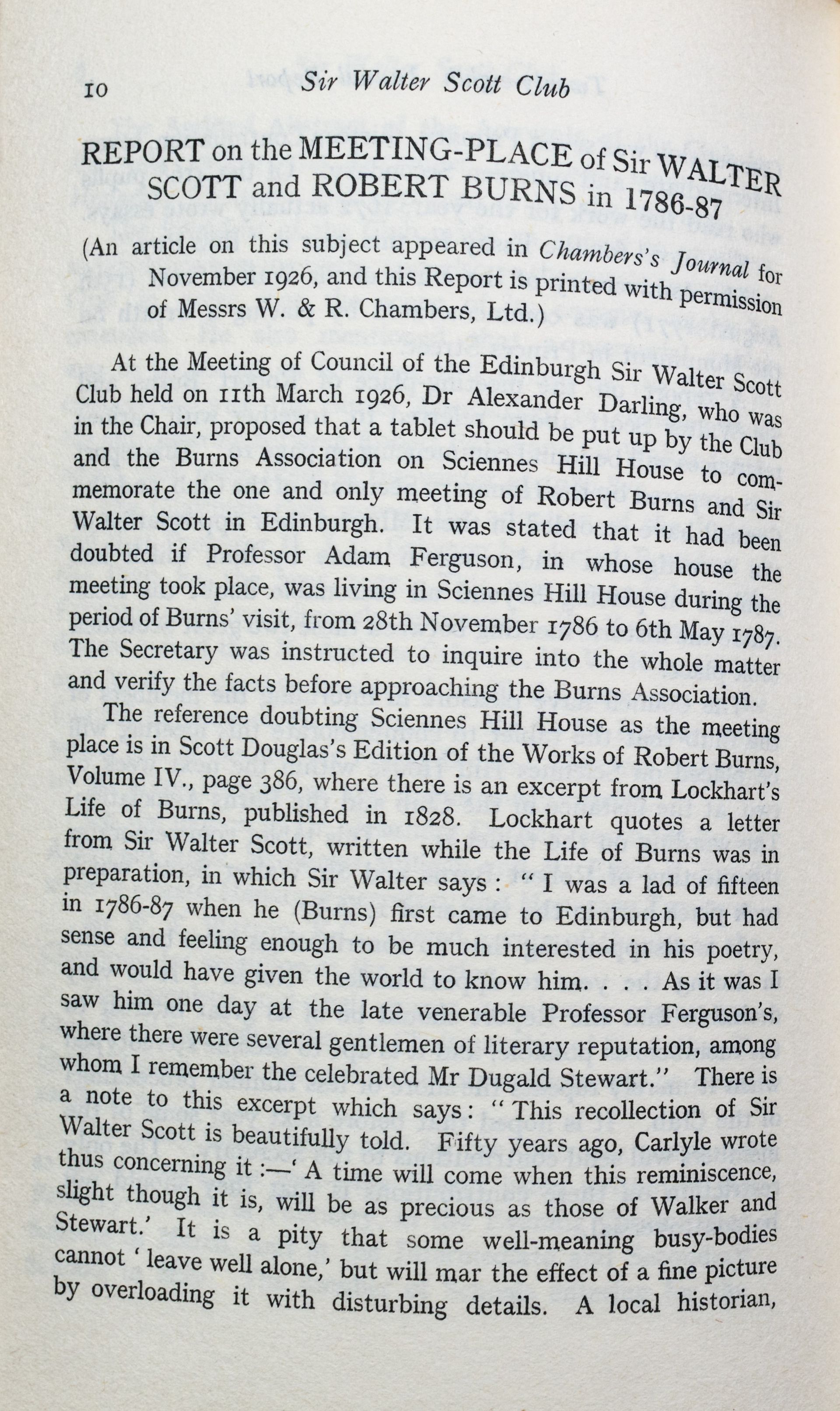The Meeting-place of Sir Walter Scott and Robert Burns
Various
Article from 28th Annual Report
Summary of the Article:
This document examines the only known meeting between Sir Walter Scott and Robert Burns, which occurred in 1787 at the house of Professor Adam Ferguson in Edinburgh. The purpose of the meeting and its exact location have been debated, leading to investigations by the Edinburgh Sir Walter Scott Club.
- The Location: The meeting took place at Sciennes Hill House, which was the residence of Professor Ferguson during Burns' visit to Edinburgh between November 1786 and May 1787. However, there had been doubts about this due to conflicting historical references and the confusion between various addresses. The Club, after research and references to historical records, confirmed that Sciennes Hill House was indeed the correct location.
- The Context of the Meeting: Burns came to Edinburgh to oversee the printing of his second edition of poems. The gathering at Ferguson’s house was significant because it provided a chance for Burns to meet several distinguished figures, including Ferguson, his colleagues, and younger individuals like Scott.
- The Only Encounter: This meeting is noteworthy because it was the only time Scott and Burns met. Scott, then a young boy, was a guest at Ferguson’s home. Despite his youth and lack of prominence, Scott listened attentively as the others discussed literary matters.
- Personal Impressions: Sir Walter Scott later recalled this meeting in his memoirs, sharing his impression of Burns. Scott described Burns as humble, yet confident in his poetry, with a large, expressive eye that revealed his passion for literature. This recollection highlights Burns’ profound impact on Scott, despite the brief interaction.
- The Influence of Ferguson: Dr. Ferguson’s home was a gathering spot for many prominent intellectuals, including historians, chemists, and philosophers. This circle played a significant role in shaping the intellectual environment of Edinburgh during that time. Scott, introduced to this circle by Ferguson's son, gained a wealth of literary exposure.
- Subsequent Investigations: Historical records and local historians provided further evidence supporting Sciennes Hill House as the site of the meeting. Additionally, investigations into the property’s ownership and its history solidified its significance as the meeting-place.
Interesting Points:
- Historical Debate: There were doubts about the location of the meeting, with conflicting references in historical documents. The investigation by the Edinburgh Sir Walter Scott Club helped clarify the issue.
- Scott’s Early Impression of Burns: Scott’s youth and modest background were key elements in his later writings. This first-hand meeting with Burns helped shape his admiration for the poet.
- The Role of Ferguson: Ferguson’s influence as a mentor and intellectual leader in Edinburgh is crucial. He introduced many, including Scott, to key literary and philosophical figures, playing an indirect role in Scott’s literary development.
- The Significance of Sciennes Hill House: The house, later referred to as ‘Kamchatka’ due to its location, has a rich history tied to significant literary gatherings and the birth of future literary connections.
- The Printed Image That Moved Burns: The account of Burns being moved to tears by an image (of a soldier’s death) is striking, revealing his sensitivity to art and poetry.
These elements offer a fascinating glimpse into the early interactions of two literary giants and the intellectual world they inhabited.
Download the [transcript] or read the [bulletin]

Download the [transcript] or read the [bulletin]
An article on this subject appeared in Chambers's Journal for November 1926, and this Report is printed with permission of Messrs W. & R. Chambers, Ltd.


